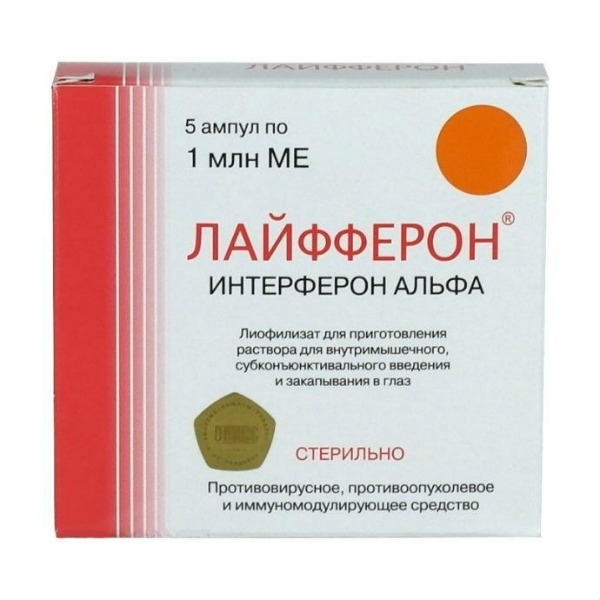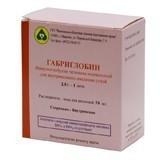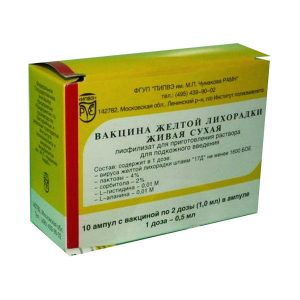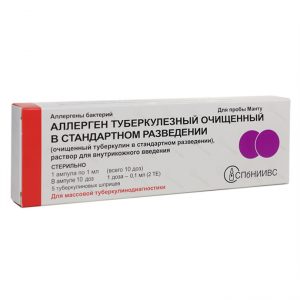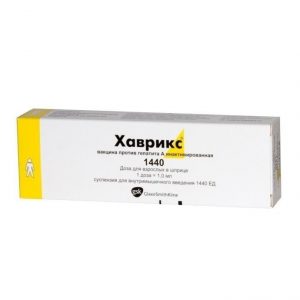Description
Release form srdlpkrd47 drug Lifeferon ® has antiviral, antitumor, immunomodulating activity.
Pharmacokinetics of
Lifeferon ® under parenteral administration is disintegrated, partially excreted unchanged, mainly through the kidneys. Like all interferons. in individuals with prolonged use, the drug can cause the appearance of antibodies to interferon, which leads to a decrease in the therapeutic effect.
Indications
Adults in combination therapy:
of acute viral hepatitis B – moderate and severe forms at the beginning of the icteric period up to the 5th day of jaundice (later administration of the drug is less effective in case of developing hepatic coma and cholestatic disease)
of acute prolonged hepatitis B and C, chronic active hepatitis B and C including with a delta agent, without signs of cirrhosis and with signs of cirrhosis of the liver
viral (influenza, adenovirus, enterovirus, herpetic, mumps), virus-bacterial and mycoplasmal meningoencephalitis. The use of
drug is most effective in the first 4 days of stage IV
kidney cancer, hairy cell leukemia, malignant skin lymphomas (fungal mycosis, primary reticulosis, rsticulosarcomatosis), Kaposi s sarcoma. basal cell and squamous cell carcinoma of the skin, keratoacanthomas. chronic myelogenous leukemia, histiocytosis from Laigergans cells, subleukemic myelosis, essential thrombocythemia
multiple sclerosis.
viral conjunctivitis, keratoconjunctivitis. keratitis, keratoiridocyclitis, keratouveitis.
For children from 1 year of age as part of complex therapy:
of acute lymphoblastic leukemia in remission after inductive chemotherapy (for 4-5 months of remission)
juvenile laryngeal respiratory papillomatosis of the larynx, starting from the day after the removal of papillomas.
Contraindications
Hypersensitivity to the components of the drug
severe allergic diseases
pregnancy
lactation.
Special instructions
In case of severe adverse reactions or if they persist for a long time, at the doctor s discretion, a temporary dose reduction is allowed (with a decrease in the number of platelets to less than 50,000 cells in 1 μl of the absolute number of neutrophils below 750 cells in 1 μl) or interruption of treatment (with a decrease in the number of platelets to a level of less than 25,000 cells in 1 μl, the absolute number of neutrophils is less than 500 cells in 1 μl).
Effect on the ability to drive vehicles,
mechanisms During the use of the drug, patients experiencing fatigue, drowsiness, or disorientation should refrain from engaging in potentially dangerous activities that require increased concentration of attention and speed of psychomotor reactions.
Composition
Lyophilisate for the preparation of a solution for intramuscular, subconjunctival administration and instillation into the eye in the form of a white powder or porous mass hygroscopic.
1 amp
interferon alfa-2b human recombinant 1,000,000 IU
Excipients: sodium chloride – 9.2 mg, sodium hydrogen phosphate dodecahydrate (sodium phosphate disubstituted 12-aqueous) – 2.74 mg, sodium dihydrogen phosphate dihydrate (0.3 mg phosphate) , dextran with m.m. from 30,000 to 40,000 (in view of the Reonopoliglukin solution containing 100 mg / 1 ml of dextran in 0.9% sodium chloride solution) – 8 mg, sorbitol (D-sorbitol) – 3 mg, urea (urea) – 0.1 mg.
Dosage and Administration
LIFFSRON ® is administered intramuscularly, into or near the lesion, subconjunctival or topically. Immediately before use, the contents of the ampoule (vial) are dissolved in water for injection or in a 0.9% solution of sodium chloride (in 1 ml for intramuscular injection and in the focus, in 5 ml for subconjunctival and local administration). The solution of the drug should be colorless, with weak opalescence. without sediment and foreign inclusions. Dissolution time should be about 10 minutes.
Intramuscular administration of
In acute viral hepatitis B, the drug is administered at 1 million ME 2 times / day for 5-6 days, then the dose is reduced to 1 million ME / day and administered for another 5 days. If necessary (after control biochemical blood tests), the course of treatment can be continued by the introduction of 1 million ME 2 times a week for 2 weeks. The course dose is 15-21 million ME.
In acute, protracted and chronic viral hepatitis B with the exception of delta infection and without signs of cirrhosis, the drug is administered 1 million ME 2 times a week for 1-2 months. If there is no effect, treatment can be extended up to 3-6 months, or after the end of 1-2 months of therapy, 2-3 similar courses can be taken with an interval of 1-6 months.
In chronic viral hepatitis B with a delta agent without signs of liver cirrhosis, the drug is administered 0.5-1 million. ME per day 2 times a week for 1 month. A second course of treatment after 1-6 months.
In chronic viral hepatitis B with a delta agent and signs of liver cirrhosis, the drug is administered at 0.25-0.5 million ME per day 2 times a week for 1 month. When signs of decompensation appear, similar courses are repeated at intervals of at least 2 Meeys.
In acute, protracted and chronically active hepatitis C without signs of liver cirrhosis, the drug is administered 3 million ME 3 times a week for 6-8 months. In the absence of effect, treatment should be extended to 12 months. A second course of treatment – after 3-6 months.
For viral, viral, bacterial and mycoplasma meningoencephalitis, the drug is administered at 1 million ME 2 times / day for 10 days as part of complex therapy with antiviral and antibacterial chemotherapy drugs. The dose and treatment regimen are set individually, depending on the severity of the patient’s condition.
In kidney cancer, the drug is used at 3 million IU / day for 10 days. Repeated courses of treatment (3-9 or more) are carried out with an interval of 3 weeks. The total dose of the drug is from 120 million IU to 300 million IU or more.
With hairy cell leukemia, the drug is administered daily at 3-6 million ME for 2 months. After normalizing the hemogram, the daily dose of the drug is reduced to 1-2 million ME, then prescribed in a maintenance dose of 3 million ME 2 times a week for 6-7 weeks. The total amount of the drug is 420-600 million ME or more.
In acute lymphoblastic leukemia in children during remission after the end of inductive chemotherapy (for 4-5 months of remission) – 1 million ME 1 time per week for 6 months, then 1 time in 2 weeks for 24 months. At the same time, maintenance chemotherapy is performed.
In malignant lymphomas and Kaposi s sarcoma, the drug is administered at 3 million ME / day daily for 10 days in combination with cytostatics (prospidine, cyclophosphamide) and GCS. In the tumor stage of fungoid mycosis and reticulosarcomatosis, it is advisable to alternate the intramuscular injection of the drug at 3 million ME and the intrafocal at 2 million ME for 10 days.
In patients with the erythrodermic stage of fungoid mycosis, when the body temperature rises above 39 ° C and in case of exacerbation of the process, the drug should be discontinued. With insufficient therapeutic effect, after 10-14 days, a second course of therapy is prescribed. After achieving the clinical effect, maintenance therapy is prescribed at 3 million ME once a week for 6-7 weeks.
In chronic myeloid leukemia, the drug is administered in 3 million. ME daily or 6 million ME every other day. The duration of treatment is from 10 weeks to 6 months.
With histiocytosis from Langerhans cells, the drug is administered at 3 million ME / day for 1 month. Repeated courses are carried out at 1-2-month intervals for 1-3 years.
In case of subleukemic myelosis and essential thrombocytopenia, the drug is administered at 1 million ME daily or every other day for 20 days to correct hypertrombocytosis.
In juvenile respiratory laryngeal papillomatosis, the drug is administered at 100-150 thousand ME per kg of body weight daily for 45-50 days, then at the same dose 3 times a week for 1 month. The second and third course is carried out with an interval of 2-6 months.
In multiple sclerosis, the drug is prescribed at 1 million ME with pyramidal syndrome 3 times / day, with cerebellar syndrome – 1-2 times / day for 10 days, followed by 1 million. ME 1 time per week for 5-6 months. The total amount of the drug is 50-60 million ME.
Persons with a high pyrogenic reaction (body temperature 39 ° C and above) to the introduction of the drug is recommended the simultaneous use of paracetamol and indomethacin.
Perifocal administration of
With basal cell and squamous cell carcinoma, keratoacanthoma, the drug is administered under the lesion of 1 million ME 1 time / day daily for 10 days. In the case of severe local inflammatory reactions, administration under the lesion is carried out after 1-2 days. At the end of the course, if necessary, cryodestruction is performed.
Subconjunctival administration of
With stromal keratitis and keratoiridocyclitis, subconjunctival injections of the drug are prescribed in a dose of 60 thousand ME (in a volume of 0.5 ml) daily or every other day, depending on the severity of the process. Injections are performed under local anesthesia with 0.5% dicaine solution. The course of treatment is from 15 to 25 injections.
Topical application
To prepare a solution for topical application, 5 ml of 0.9% sodium chloride solution for injection is added to the contents of the ampoule (1 million ME). In the case of storing a solution of the drug, it is necessary, following the rules of asepsis and antiseptics, transfer the contents of the ampoule to a sterile vial with a stopper and store the solution in the refrigerator at 4-10 ° C for no more than 12 hours.
For conjunctivitis and superficial keratitis, 2 are applied to the conjunctiva of the affected eye drops of solution 6-8 times / day. As the inflammatory phenomena disappear, the number of instillations is reduced to 3-4 times / day. The course of treatment is 2 weeks.
Side effects of
With parenteral administration of the drug, chills, fever, fatigue, headache, malaise, and flu-like syndrome are possible. These side effects are partially stopped by paracetamol or indomethacin.
With topical application of the drug on the mucous membrane of the eye, conjunctival infection, hyperemia of the mucous membrane of the eye, single follicles, edema of the conjunctiva of the lower arch are possible.
When using the drug, deviations from the norm of laboratory parameters are possible, manifested by leukopenia, lymphopepia, thrombocytopenia, an increase in the level of alanine amipotransferase, alkaline phosphatase. For the timely detection of these deviations during therapy, general clinical blood tests must be repeated every 2 weeks, and biochemical – every 4 pedals. As a rule, these changes are usually minor, asymptomatic and reversible.
Overdose
There have been no cases of overdose. Given that the active substance is interferon alfa-2b, an overdose may increase the severity of side effects.
Treatment: withdrawal of the drug if necessary, conduct symptomatic therapy.
Storage conditions
The drug should be stored in a dark place and out of the reach of children at a temperature not exceeding 8 ° C.
Not to be used after the expiration date.
Expiration
3 years.
Deystvuyuschee substances
interferon alfa-2b
dosage form
injection
